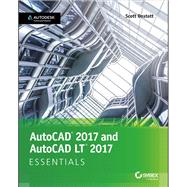AutoCAD 2017 and AutoCAD LT 2017 Essentials is the unique task-based tutorial designed for both students and the professional AutoCAD user. Concise, straightforward explanations and real-world, hands-on exercises provide an authoritative, easy-to-follow guide to the platform's core features and functions. Step-by-step tutorials are backed by full-color screenshots, and each chapter ends with an open-ended project to reinforce the chapter's lessons and provide a fully immersive learning experience. The companion website features downloadable before-and-after tutorial files, so you can jump in at any point and compare your work with the pros. This new edition has been fully updated to align with AutoCAD's newest features and capabilities, and features a more approachable, easy-to-read style based on instructor and reader feedback to help you get up to speed and quickly become productive with the software.
AutoCAD is the leading design and drawing software, and an essential skill for designers, architects, and engineers. Whether you're new to the software, upgrading, or preparing for certification, this no-nonsense guide is your ideal resource for complete AutoCAD instruction.
- Master 2D drawing using splines, polylines, layers, and objects
- Add detail with hatching, gradients, text, and dimensions
- Convert your design into a 3D model for a walk-through tour
- Import, print, edit, and present your final design
By following a real-world professional workflow throughout the learning process, you develop a highly relevant set of skills that easily transfer into real-world projects. This book walks you through the design of a house, emphasizing skills rather than tools to equip you with an array of solutions for any AutoCAD task. If you're serious about AutoCAD and ready to get down to work, AutoCAD 2017 and AutoCAD LT 2017 Essentials is the guide you need at your fingertips.








